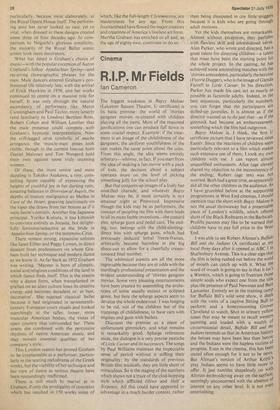Dance
Graham
Jan Murray
Who but Martha Graham would have the temerity to close a Royal Gala with a suicide, Jocasta's—a portent of dark deeds to follow during this first contemporary dance season in what Graham calls 'the sanctity of Covent Garden'.
Wisely, programmes have been varied to provide a celebratory survey of Graham's monumental achievement. Though the dramas based on Greek myths are the heartbeat of her 'interior landscape', and five are being mounted here, audiences have responded with most fervour to the radiant lyricism of Diversion of Angels. An abstract work, it displays a young, comparatively lightweight ensemble to best advantage, and enables the uninitiated to grasp the essentials of Graham's revolutionary technique with the minimum of effort.
Not that Miss Graham would approve, for life, she says repeatedly, is effort, and her technique is designed not to beautify but to free the body and make visible the engineering. The torso is the source of the motor energy, the spine its flexible spring around which movements spiral. Whereas air is the element of classical ballet, the earth is Graham's base. Through contraction and release, analogous to the process of breathing, a current flows from the centre along the limbs like a whiplash, and the dancer carves his own space from a seemingly resistant medium. Always gravity is used, not defied, the ground incorporated into the choreography much as Graham integrates Isamu Noguchi's free-standing sculptures into the action of her words. It is this wholeness of vision which has made Graham an original, generic force not only in dance, but in all of twentieth-century western theatre.
Certainly the potent combination of Noguchi's sets, Graham's animate costumes and Jean Rosenthal's lighting should inspire a reappraisal of staging for British dance particularly, because most elaborately, at the Royal Opera House itself. The performing area has never looked so vast, yet so vital, when dressed in these designs created some three or four decades ago. In comparison to Noguchi's glorious simplicity, the majority of the Royal Ballet scenic artists look mere decorators.
What has dated is Graham's choice of music—with the popular exception of Aaron Copland's folksy Appalachian Spring—and recurring choreographic phrases for the men. Male dancers entered Graham's professional life relatively late, with the arrival of Erick Hawkins in 1938, and her works continued to centre on a massive role for herself. It was only through the natural ascendancy of performers like Merce Cunningham and Paul Taylor, more latterly (and familiarly to London) Bertram Ross, Robert Cohan and William Louther that the male presence could compete with Graham's hypnotic interpretations. Now the stiff-legged strut symbolic of macho arrogance, the 'muscle-man' poses look risible, though in the current line-up' both Daniel Maloney and Tim Wengerd hold their own against some truly stunning women.
Of these, the most senior and most dazzling is Takako Asakawa, a tiny, compelling figure capable of expressing the heights of youthful joy in her darting runs, amazing balances in Diversion of Angels, the depths of/mature malignancy as Medea in Cave of the Heart, gnawing lasciviously on the viper she draws from her bosom as if it were Jason's entrails. Another fine Japanese principal. Yuriko Kimura, is too kittenish to convince entirely as Jocasta, but delightfully feminine/seductive as the bride in Appalachian Spring, or the temptress Circe.
There remain strong, expansive soloists like Janet Eilber and Peggy Lyman, in direct descent from predecessors on whom Graham built her technique and modern dance as we know it. As far back as 1932 Graham was writing, 'Manner is born of climatic, social and religious conditions of the land in which dance finds itself. This is the reason why a dance form, when transplanted or grafted on an alien culture loses its creative energy and becomes decadent or, at best, decorative'. She, rejected classical ballet because it had originated in seventeenthcentury European court rituals and looked searchingly at the taller, looser,more muscular American bodies, the vistas of open country that surrounded her. These assets she combined with the percussive rhythms of native American music, and they remain essential qualities of her company's style.
This London season has proved Graham to be irreplaceable as a performer, particularly in the searing melodrama of the Greek works, but the viability of her technique and her view of dance as serious theatre have been resoundingly reaffirmed.
There is still much to marvel at in Graham, if only the prodigality, of invention which has resulted in 150 works some of which, like the full-length Clytemnestra, are masterpieces for any age. From this fountainhead have flowed the major creators and creations of America's liveliest art form. Martha Graham has enriched us all and, at the age of eighty-two, continues to do so.



































 Previous page
Previous page